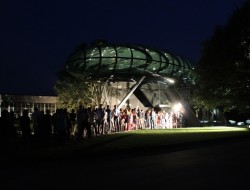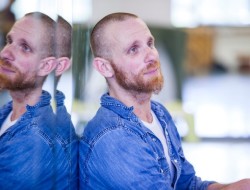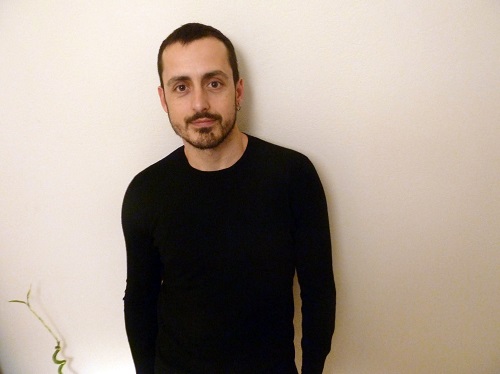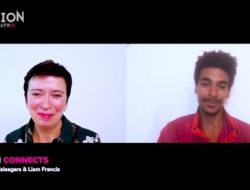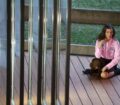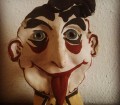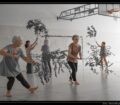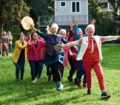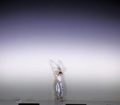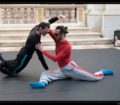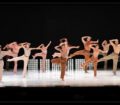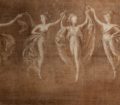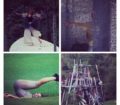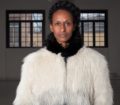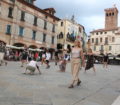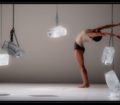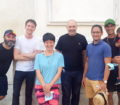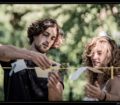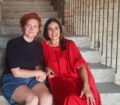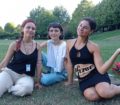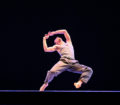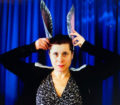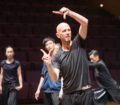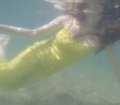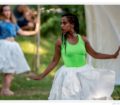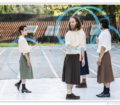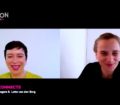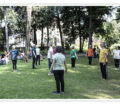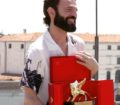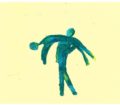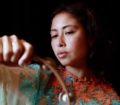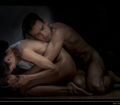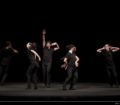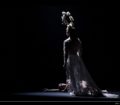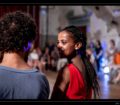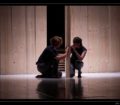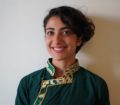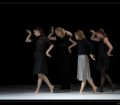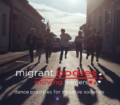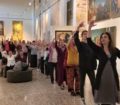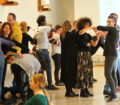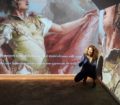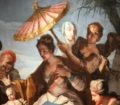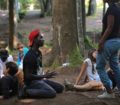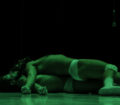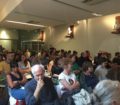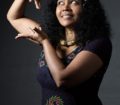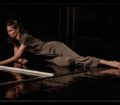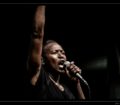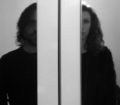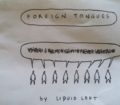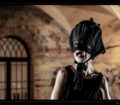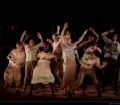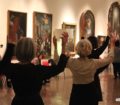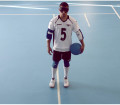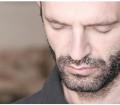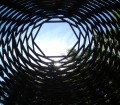Christos Papadopoulos | Interview
Elvedon flows forwards driven by precise rhythm and slinky, shifting movement patterns. A wrinkled harmony is created by six dancers as their vibrating bounces and subtle micro-movements build into a solid, but fluid whole image.
Inspired by Virginia Woolf’s The Waves, Elvedon distils the intertwined narratives of the book into an essential meditation on the passing of time. Here a deep and clear interview to choreographer Christos Papadopoulos on his concept of Time, Life, Art and kinesiological research.
Elvedon, by the Greek artist Christos Papadopoulos, is one of the works selected by the network Aerowaves and performed at Romaeuropa festival. It is hosted during Bmotion Dance 2016 – Operaestate Festival on August 26th at 9pm @ Teatro Remondini, Bassano del Grappa.
 Elvedon, why this title?
Elvedon, why this title?
In Virginia Woolf’s The Waves we follow the intertwined lives of six friends from childhood to maturity and old age. During a wondering in the forest, two of the friends discover an unknown small village. That is Elvedon. It is a magical land, a mystical place where happiness and fear, reason and emotion, life and death compose a surreal, almost magical reality, the kind that only in our dreams we are permitted to experience. That non-place in a non-time was the main frame of the performance.
What brought you to Virginia Woolf’s The Waves, and how have you translated literature into speechless dance?
The thing that moved me the most in Woolf’s The Waves is the inevitable passing of time. The lives of the six novel characters drift towards maturity and old age in a way they cannot control. Time is infinite and unstoppable. Once we start to exist we are set in a motion, a constant vibration, and we don’t have much choice but to keep moving. Woolf’s “painting” life with the colors of the ever-changing sea waves is far from just a random choice. Waves contain rhythm, sequence, repetition. As we do. When we gaze at them our inner rhythm harmonizes with theirs. That moment is crucial to me. At that moment our mind is active, clear and free. My goal was to make a performance that narrates in an abstractive manner, yet creates a meditative atmosphere that allows the audience to think and feel in an utterly free and personal manner.
Subtle corporal motion, repetition and gradual evolution are my tools to approach the theme of time. Repetition should not be interpreted as obsession. On the contrary for me depicts life’s pulse. This pulse is the glue in the lives of the six novel characters, who even though seem to be drifting alone towards the end of their lives, they travel bound firmly together by their common course.
In The Waves Virginia Woolf is concerned with the individual consciousness and the ways in which multiple consciousnesses can weave together. How do you explore the concepts of individuality, self and community?
For me the Waves by Virginia Woolf is an elegy on life. I consider it a guide for our reconciliation with our predestined journey on this earth. Our personal ups and downs, our moments of joy, sadness, love, fear or pain are nothing more than aspects of the “Whole”, and have nothing to do with the concepts of badness or goodness. I feel that through these six characters Woolf does not intend just to depict six lives, but to convey a greater picture, that extends far beyond the human existence.
The main axis of the process was the development of a simple kinesiological material based on an equally simple rhythmical pulse. Eventually we understood that the material “demanded” simplicity and less narration. Each movement can be divided into infinite intermediate ones, as important as the beginning and the end of it. The origin and the destination don’t matter more than the journey connecting them. Through repetition, this movement gradually evolves and leads us to the next one, as if this was the only possible path. The performers have to take this motion for granted. As a natural state of being. A starting point to face the world, to create relations, to connect with space, to be extrovert. The repetition of this material for an excessive period of time, led us to some very useful conclusions: the more we resisted our natural tendency for composition and complexity the more we realized that we can create a meditative atmosphere, inviting the audience into our world. This way, the audience becomes more involved, motivated and free to give their own interpretation.
In these multiple journeys from childhood through adulthood, what is your meaning of time?
Even though it might feel different to us, time is constant and infinite, whether we are in childhood or old age. It is life itself and our conscience that have limits we cannot control or evade. To our disappointment, life only lasts a tiny fraction of time. That is why it is so hard for us to consider time as infinite. Inevitably, we have learnt to perceive reality in a linear manner, and we prefer to give convenient characterizations to periods of time, like past, present, imminent, temporal, permanent. However, as I understand it, time has nothing to do with our living. It just exists. If sometimes time becomes hostile, fast, slow, comforting, agonizing or alleviating it is only due to our human nature. Time is the most essential part of this journey. It serves as the means and the motor. It is this universal, inconceivable principle that unites us all, towards our inevitable destiny. Ultimately, time is life.
On stage there are six performers, as the six characters that speak in Woolf’s novel. How do you choose your dancers?
The way I approach these six characters is quite different than the writer does in her novel. It is not my intention to build six different personalities with obvious differentiating characteristics and behavioral patterns. I let time to take over and do all the work. That is why I have chosen performers who can adjust and function under strict kinesiological guidelines, where accuracy and precision even in the tiniest motions are of paramount importance. At the same time each one has a unique personal style when performing, something that I value in a dancer. Their personal style and their perspective on the subject of Elvedon start to emerge gradually during the ample time given on stage. In that way, the audience has the opportunity to observe the subtle differences and tiny variations in the material that reflect and compose each character.
Which part does the original music composed by Coti K. play in the performance?
In Elvedon, the music by Coti K. connects with the core of the subject of the performance in the most profound way. Music after all is Time. It is not used as a supporting tool for the motion. The music harmonizes with the dancers’ heartbeat, with their human existence. Coti K. has managed to form a parallel reality of sounds that coexists and interacts with the reality of people on stage. These two parallel worlds are creating a common experience.
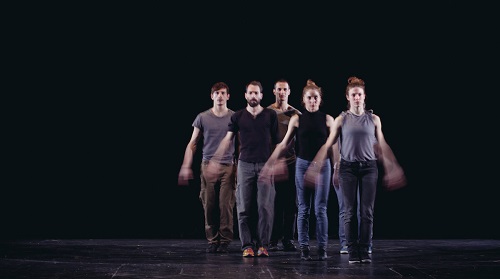 What’s the aim of your dance company Leon and the Wolf?
What’s the aim of your dance company Leon and the Wolf?
When establishing Leon and the Wolf Dance Company in 2015, I had a very clear vision. Basic target of the team is to return to a clearly kinesiological and corporal research, to consider the body the main narrative tool, to focus on the abstract motion and its subtle evolution, and all that based on the principle that simplicity is a virtue.
From theatre to dance. You graduated from the Dramatic School of the National Theatre of Greece. What made you decide for the School for New Dance Development in Amsterdam?
I have always resisted accepting the notion that theatre and dance are two different forms of art with different rules. Even though I understand that the means of narration may differ, however, it is my belief that speech and motion spring from the same origin within us, in order to satisfy the same, deep-rooted need for communication. That is what motivated me to continue my studies in School for New Dance Development (SNDO) in Holland, after graduating from Greek National Theatre Drama School, and to finally discover the art of Dance.
Besides being a performer and a choreographer, you are also an instructor of composition and improvisation. What is your technique based on?
When giving a seminar or teaching a course I like to start working by introducing a very clear and specific limitation. The form of the limitation depends upon the aim of the seminar and the subject of my kinesiological research. This limitation works as my working basis. Improvisation comes next to enrich, explore and develop the initial material. The final composition is a synthesis of the different approaches and interpretations by the members of the team.
Elvedon has been one of the few works selected by the network Aerowaves. How has this experience impacted your work and your career?
Elvedon was my first solo project as a choreographer and was accepted by the European network Aerowaves. This was a breakthrough for the piece and also helped a lot my career. I got the opportunity to communicate my work to important people in the field as well as famous dance institutes. After that, presentation of Elvedon in many European cities followed, which would have been practically impossible for an emerging choreographer, like me. This organization brings together choreographers, programmers and audiences from all around the world, enhancing a bridge of communication and sharing of thoughts that is truly crucial for the artistic expression and the development of a choreographer.
by Lara Crippa
Elvedon on Vimeo https://vimeo.com/138904862
Concept-Choreography: Christos Papadopoulos
Original Music: Coti K.
Lighting design: Miltos Athanasiou
Costume design: Aggelos Medis
Videographer: Patroklos Skafidas
Performers: Ermis Malkotsis, Georgios Kotsifakis, Ioanna Paraskevopoulou, Hara Kotsali, Nadi Gogoulou, Epaminondas Damopoulos
Production: Christos Papadopoulos – Leon & the Wolf
Tags: Aerowaves, Bmotion 2016, Christos Papadopoulos, operaestate

